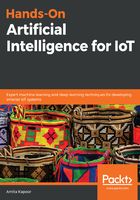
上QQ阅读APP看书,第一时间看更新
AI platforms and IoT platforms
A large number of cloud platforms with both AI and IoT capabilities are available today. These platforms provide the capability to integrate the sensors and devices and perform analytics on the cloud. There exist more than 30 cloud platforms in the global market, each targeting different IoT verticals and services. The following screenshot lists the various services that AI/IoT platforms support:

Services that different AI/IoT platforms support
Let's briefly find out about some popular cloud platforms. In Chapter 12, Combining it all together, we'll learn how to use the most popular ones. The following is a list of some of the popular Cloud platforms:
- IBM Watson IoT Platform: Hosted by IBM, the platform provides device management; it uses the MQTT protocol to connect with IoT devices and applications. It provides real-time scalable connectivity. The data can be stored for a period and accessed in real time. IBM Watson also provides Bluemix Platform-as-a-Service (PaaS) for analytics and visualizations. We can write code to build and manage applications that interact with the data and connected devices. It supports Python along with C#, Java, and Node.js.
- Microsoft IoT-Azure IoT suite: It provides a collection of preconfigured solutions built on Azure PaaS. It enables a reliable and secure bidirectional communication between IoT devices and cloud. The preconfigured solutions include data visualization, remote monitoring, and configuring rules and alarms over live IoT telemetry. It also provides Azure Stream Analytics to process the data in real time. The Azure Stream Analytics allows us to use Visual Studio. It supports Python, Node.js, C, and Arduino, depending upon the IoT devices.
- Google Cloud IoT: The Google Cloud IoT provides a fully managed service for securely connecting and managing IoT devices. It supports both MQTT and HTTP protocols. It also provides bidirectional communication between IoT devices and the cloud. It provides support for Go, PHP, Ruby, JS, .NET, Java, Objective-C, and Python. It also has BigQuery, which allows users to perform data analytics and visualization.
- Amazon AWS IoT: The Amazon AWS IoT allows IoT devices to communicate via MQTT, HTTP, and WebSockets. It provides secure, bi-directional communication between IoT devices and the cloud. It also has a rules engine that can be used to integrate data with other AWS services and transform the data. Rules can be defined that trigger the execution of user code in Java, Python, or Node.js. AWS Lambda allows us to use our own custom trained models.